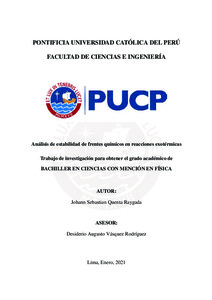Análisis de estabilidad de frentes químicos en reacciones exotérmicas
Abstract
Buoyancy-driven convection is a phenomenon that appears in a wide range of natural processes,
from atmospheric and oceanic flows to the Earth’s core inner dynamics. In particular, convective
flows are ubiquitous in systems of chemical substances reacting at an interface known as a
reaction front. Autocatalytic reaction fronts allow for different types of instabilities due to
gradients in chemical composition and the exothermicity of the reaction. In order to study the
effects of thermal gradients in such systems, we develop a model for thin-front propagation in
two-dimensional tubes. Temperature and front evolution are coupled to two different descriptions
of the system’s hydrodynamics: Darcy’s law and the Navier-Stokes equations for viscous
flows. We study the stability of the convectionless flat front by carrying out a linear stability
analysis. The regimes for which convection arises will depend on a control parameter, called the
thermal Rayleigh number, which measures the strength of thermal gradients in the system. We
vary this parameter between positive and negative values and analyze its effects on the stability
of the fronts.
Temas
Dinámica de fluidos
Frentes químicos
Reacciones químicas
Frentes químicos
Reacciones químicas
Para optar el título de
Bachiller en Ciencias con mención en Física
Collections
The following license files are associated with this item:






